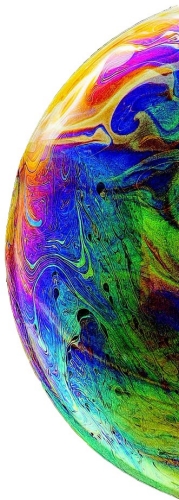Can Soap Bubbles Predict Tropical Storms?

By Julianne Glaser
Meteorology is a complex and imprecise science. Despite technological advancements, forecasting volatile weather patterns, such as tropical storms, remains a challenge as it involves predicting numerous dynamic atmospheric and environmental interactions. Results of recent research however, have shown that soap bubbles may provide a simple, inexpensive and effective means for predicting the strength of hurricanes and typhoons.
Soap Bubbles And Vortices
Recently, physicists at the Laboratoire Ondes et Matiere d’Aquitaine, in collaboration with researchers from the Institut de Mathematiques de Bordeaux and a team from Universite de la Reunion, conducted an innovative experiment utilizing soap bubbles to simulate atmospheric flow. The team detailed rotation rates of soap bubble vortices through colorful whirls on the bubble surface that reproduced the curvature of the atmosphere and developed a simple model that would similarly predict that of tropical cyclones.
This experiment allowed scientists to create miniature cyclonic vortices models similar to tropical storms, to measure rotation rates and track storm intensity. They discovered that the initial rotation and intensity of vortices was very weak, but increased significantly over a short period of time. Following this intensification phase, the vortices rotation speed and intensity peaked before entering a state of decline.
To verify their simulations on a larger scale, the research team applied this data to the evolutionary intensity of 150 low-pressure tropical cyclones in the Pacific and Atlantic oceans and found it held true. The results, as published in Scientific Report, indicate that prediction of a developing tropical cyclone can begin 50 hours after initial formation of the vortex, about one quarter of its lifetime when the storm is intensifying and winds strengthening.
This innovative research could result in meteorological advancements and provide a critical model for early prediction of tropical cyclones and hurricanes that may quite literally save lives and reduce property damage for coastal areas worldwide.
Extension Questions
- How does El Niño affect weather patterns and impact tropical storm formation?
- What are the major hurricanes to hit the United States in the last 100 years? Would early warning of these storms have made a difference?
- What other ways can meteorology impact our lives and work?